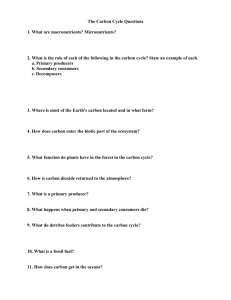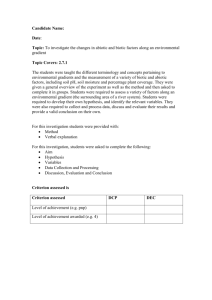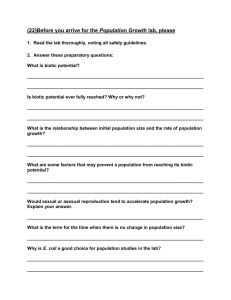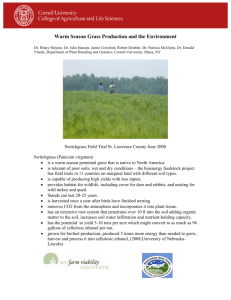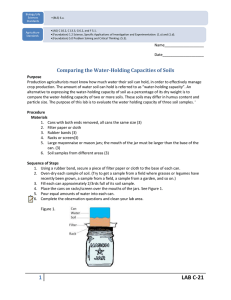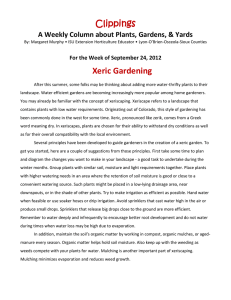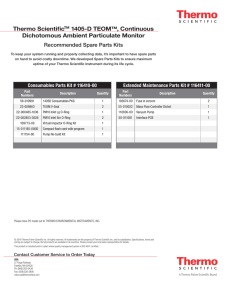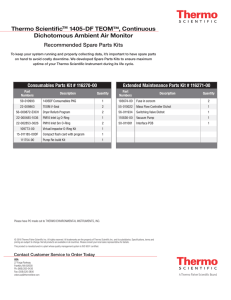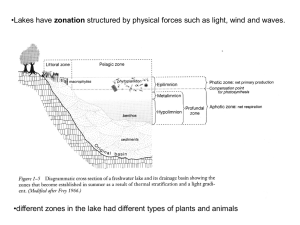Concept Map - Kwanga.net
advertisement
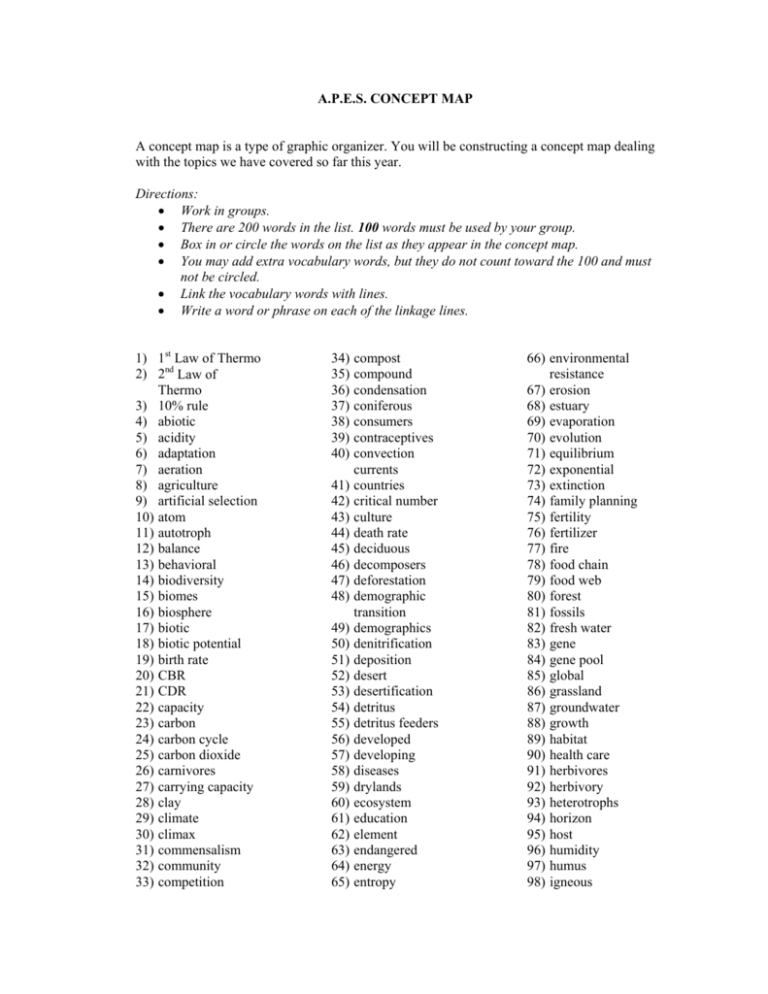
A.P.E.S. CONCEPT MAP A concept map is a type of graphic organizer. You will be constructing a concept map dealing with the topics we have covered so far this year. Directions: • Work in groups. • There are 200 words in the list. 100 words must be used by your group. • Box in or circle the words on the list as they appear in the concept map. • You may add extra vocabulary words, but they do not count toward the 100 and must not be circled. • Link the vocabulary words with lines. • Write a word or phrase on each of the linkage lines. 1) 1st Law of Thermo 2) 2nd Law of Thermo 3) 10% rule 4) abiotic 5) acidity 6) adaptation 7) aeration 8) agriculture 9) artificial selection 10) atom 11) autotroph 12) balance 13) behavioral 14) biodiversity 15) biomes 16) biosphere 17) biotic 18) biotic potential 19) birth rate 20) CBR 21) CDR 22) capacity 23) carbon 24) carbon cycle 25) carbon dioxide 26) carnivores 27) carrying capacity 28) clay 29) climate 30) climax 31) commensalism 32) community 33) competition 34) 35) 36) 37) 38) 39) 40) 41) 42) 43) 44) 45) 46) 47) 48) 49) 50) 51) 52) 53) 54) 55) 56) 57) 58) 59) 60) 61) 62) 63) 64) 65) compost compound condensation coniferous consumers contraceptives convection currents countries critical number culture death rate deciduous decomposers deforestation demographic transition demographics denitrification deposition desert desertification detritus detritus feeders developed developing diseases drylands ecosystem education element endangered energy entropy 66) environmental resistance 67) erosion 68) estuary 69) evaporation 70) evolution 71) equilibrium 72) exponential 73) extinction 74) family planning 75) fertility 76) fertilizer 77) fire 78) food chain 79) food web 80) forest 81) fossils 82) fresh water 83) gene 84) gene pool 85) global 86) grassland 87) groundwater 88) growth 89) habitat 90) health care 91) herbivores 92) herbivory 93) heterotrophs 94) horizon 95) host 96) humidity 97) humus 98) igneous 99) industrial revolution 100) infiltration 101) interspecific 102) intraspecific 103) inorganic 104) irrigation 105) J-curve 106) leaching 107) lethal 108) limiting factors 109) loam 110) matter 111) metamorphic 112) microlending 113) migration 114) mineralization 115) molecule 116) momentum 117) mortality 118) mutation 119) mutualism 120) natural 121) natural selection 122) Neolithic revolution 123) neutral 124) nitrogen 125) nitrogen fixation 126) non-native 127) nutrient-holding 128) nutrients 129) omnivores 130) organic 131) overcultivation 132) overgrazing 133) parasitism 134) pavement 135) permafrost 136) pH 137) phosphorus 138) photosynthesis 139) polar 140) precipitation 141) predation 142) predator 143) prey 144) population 145) primary 146) producers 147) pyramid 148) qualitative 149) quantitative 150) rain shadow desert 151) replacement 152) respiration 153) reproduction 154) runoff 155) S-curve 156) salinization 157) salt water 158) sand 159) secondary 160) sediment 161) sedimentary 162) selective pressures 163) silt 164) sinkhole 165) soil 166) soil profile 167) 168) 169) 170) 171) 172) 173) 174) 175) 176) 177) 178) 179) 180) 181) 182) 183) 184) 185) 186) 187) 188) 189) 190) 191) 192) 193) 194) 195) 196) 197) 198) 199) 200) soil texture speciation species spring stewardship subsidence subsoil succession surface water sustainability symbiosis synthetic TFR tectonic plates temperate territoriality tertiary topsoil traits transpiration tropical tundra U.N. variation water water table water-holding watershed weathering wildlife WHO workability World Bank xeriscaping
